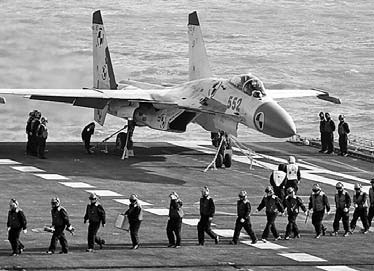Fighter jet plagiarism allegations 'offensive'
|
A J-15 fighter jet lands on the Liaoning aircraft carrier on Sunday in a training exercise in Dalian, Liaoning province. Zha Chuming / Xinhua |
China on Thursday dismissed claims that its carrier-based fighter jets plagiarized foreign models and would make Beijing more assertive in tackling maritime disputes with neighbors.
It is at least unprofessional, if not an intentional attack, to claim China copied foreign aircraft carrier technology through a simple comparison since the laws for military development are objective, and the principles of building military equipment, the command and safeguard methods are similar, Ministry of National Defense spokesman Geng Yansheng said at a regular news conference.
Geng made the remarks in response to reports that the carrier-borne J-15 fighter jet, which made its debut in a landing and take-off exercise on China's first aircraft carrier the Liaoning on Saturday, is a Chinese adaptation of the naval version of Russia's Su-33.
"China adheres to self-dependent scientific innovation. We have sufficient know-how and capability to build and develop our own aircraft carrier," Geng said.
It is true that China used to rely heavily on imported Russian military equipment to modernize its troops, but people should not use that as an excuse to criticize Chinese people who have made tough endeavors and even sacrifices in developing the J-15's engine, fire-control system, electronics system and other key components, said the Xinhua News Agency.
Guo Xiaobing, deputy chief of the Institute of Security and Arms Control Studies under the China Institutes of Contemporary International Relations, said the "crime of plagiarism" is a severe insult to Chinese researchers including Luo Yang, head of the production phase of the J-15 who died on Sunday of a heart attack during the carrier's voyage return to base after the planes' landing exercise.
Geng said the J-15, which is still conducting related experiments and training, would equip the army in accordance with the military's schedule. Experts said it will be a while before the Liaoning can be put into operation.
But its presence in the Asia-Pacific region and Beijing's newly proposed "maritime power" strategy have been detected as threats by Washington and its Asian allies. Tokyo and Manila were especially concerned amid their territorial disputes with Beijing over the Diaoyu Islands and the South China Sea.
US State Department spokeswoman Victoria Nuland said earlier that the United States was continuing to carefully monitor Chinese military developments. She urged Beijing to be as transparent as possible about its military capabilities and intentions and to use military power, including the aircraft carrier, in a way that is conducive for regional peace and stability.
"China is always open to military transparency and frankly speaking, the J-15 experiment is quite transparent," said Geng, adding that the Chinese media has had abundant and timely coverage and commentary about the plane since Sunday.
Wu Shengli, China's navy chief on Tuesday also briefed the US secretary of the Navy Ray Mabus on the J-15 and test trials of the Liaoning.
Pan Zheng, a scholar on US military studies with the People's Liberation Army National Defense University, said the US should also ask itself how transparent it has been to China.
Washington on Monday released two pictures of a US-Japan joint drill that concluded on Nov 16. The closed-door exercise is one of many that have taken place between the two countries this year. Geng said China opposes parties that intentionally highlight military agendas and frequently flare up regional tensions.
China's development of the aircraft carrier is not targeted at any third party or part of an arms race, Geng said.
Its development is based on national security and military construction needs and China's ability to invest in such a project, Geng said.
"We hope related parties view China's aircraft carrier construction in an objective and rational way," he added.
Contact the writers at zhaoshengnan@chinadaily.com.cn and lixiaokun@chinadaily.com.cn



















